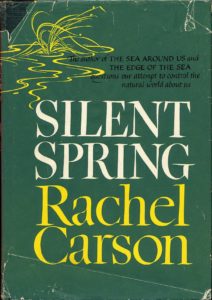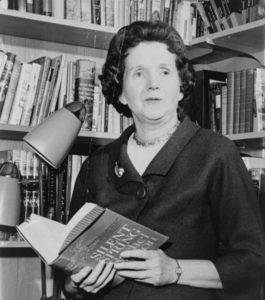
About fifteen years ago, I was stunned by the sight of a bald eagle that flew across the road while I was driving. I had never seen the gorgeous creatures outside of zoos. Now, they are a common wintertime sight in northwest Arkansas, and we even have year-round residents that nest at nearby lakes.
We have Rachel Carson to think for the resurgence of bald eagles, golden eagles, peregrine falcons, and countless other bird species whose numbers were rapidly dwindling during the 60’s. In 1962, she shocked the world with Silent Spring, a book that turned an entire generation into environmentally conscious individuals.
Rachel Carson was born in Springdale, Pennsylvania in 1907. She was interested in nature as a child, and pursued a degree in marine biology and zoology, eventually earning a Masters. She also landed a government job during the Depression writing radio scripts and picked up some side income writing articles on natural history for the Baltimore Sun. The writing bug was pretty persistent, so in 1952 she quit her lucrative government gig to pursue the muse full time.
That year saw her publish a book called The Sea Around Us. Three years later she penned The Edge of the Sea. Both tomes were successful, but the best was yet to come.
Rachel was very environmentally conscious, and was uneasy with the greatly increased use of pesticides that followed WWII. This stand climaxed with the 1962 release of Silent Spring. Her primary target in the work was DDT.
Developed in 1939, it was used during World War II to clear South Pacific islands of malaria-causing mosquitoes for U.S. troops, while elsewhere being used as an effective delousing powder. Its inventor, Dr. Paul Muller, was awarded the Nobel Prize.
But DDT was a little too effective. It was persistent. After it killed the nasty skeeters, it continued to do damage to other insects. And it had another ugly side effect: It made the eggs of birds who consumed creatures that had the long-lasting chemical in their systems paper-thin. That meant eggs would be crushed, and baby birds wouldn’t be born. The bald eagle, which ate lots of DDT-contaminated fish, eventually became quite rare in the lower 48.

Rachel decided something needed to be done. So she expressed her thoughts in her greatest work. It woke up an entire nation to the hazards of using chemicals to control pests that would also have a deleterious effect on other forms of life. Interestingly, there was also evidence that insects were becoming resistant to it. However, it continued to have its deadly effect on the eggs of raptors.
The chemical industry was not pleased. They praised DDT as one of the reasons we whipped the Japs. They pointed to how many millions of lives had been saved by wiping out malaria-laden mosquitoes since the war was over. An exec at the American Cynamid Company said “If man were to faithfully follow the teachings of Miss Carson, we would return to the Dark Ages, and the insects and diseases and vermin would once again inherit the earth.”
However, the public listened to Rachel Carson. DDT was eventually banned in the US ten years later, but the instant effect of her book was that DDT had a nasty reputation, and its use nosedived.
The last reported use of DDT was in 1994.
Among the many eagles that have been depicted on US coins have been actual depictions of Peter. Peter was a bald eagle that hung around the Philadelphia Mint in the early 19th century. By the 1960’s, the idea of seeing an eagle in the area was as far fetched as spotting a unicorn. But on March 17, 2007, it was announced that a bald eagle nest had been discovered within Philadelphia’s city limits.
Rachel Carson, who died of cancer in 1964, would have been very, very proud.